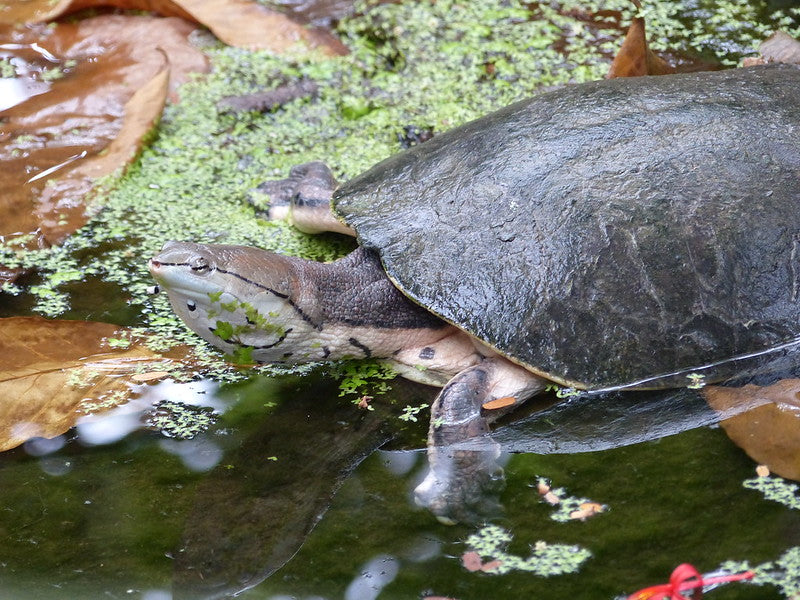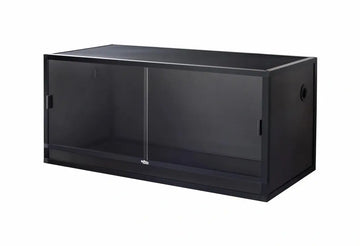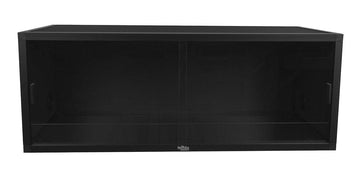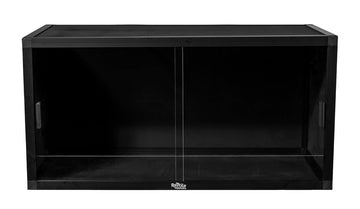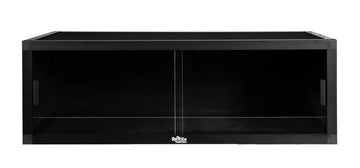Argentine side-necked turtles (Phrynops hilarii) are also known as Hilaire’s side-necked turtle. They are a 16” long, semi-aquatic, diurnal reptile found in central South America. These turtles prefer freshwater habitats with plenty of vegetation such as swamps, rivers, ponds, and lakes.
Argentine side-necked turtles have large heads, sharply tapered snouts, smooth shells, webbed feet, and two teardrop-shaped barbels under the chin. Coloring is uniform gray on top and pale below, with a thin black line to separate the two colors. These turtles also have thin dark stripes and spots decorating their underside, and each barbel features a black mark.
Argentine side-necked turtles are fairly rare in captivity, and not much is known about keeping them. This should be considered an advanced-level pet.
Minimum pond size for Argentine side-necked turtles
The minimum size enclosure for housing one adult Argentine side-necked turtle requires at least 160 gallons of water, at least as deep as 1.5x the length of the turtle itself. Of course, this species is a strong swimmer, and bigger is always better!
If your local climate and housing situation allows, Argentine side-necked turtles tend to do best when housed in an outdoor pond for at least part of the year. Not only is this the more affordable solution, but also healthier for the animal. Make sure to surround the pond’s beach area with a retaining wall at least 24” tall and buried at least 6” into the ground to prevent potential escape. For best results, cover the pond with chain link mesh to help protect your pet from potential predators.
It’s best not to house more than one Argentine side-necked turtle per enclosure.
Do Argentine side-necked turtles need UVB?
Yes! Argentine side-necked turtles require exposure to appropriate amounts of UVB in order to maintain good health and wellbeing. Providing UVB lighting to your turtle offers several benefits, including all of the vitamin D that their body needs, better appetite and activity, and a stronger immune system.
The best UVB bulbs for Argentine side-necked turtles are:
- Zoo Med Reptisun T5 HO 5.0
- Arcadia Forest 6%
The UVB bulb should be half the length of the enclosure and housed in a reflective fixture like the Arcadia ProT5 or Vivarium Electronics. Place the lamp close to the heat lamps, about 12-14” above the basking platform. UVB bulbs decay over time, so don’t forget to replace your bulb every 12 months to maintain good performance.
Since Argentine side-necked turtles are a day-active species, it’s best practice to provide extra illumination via a strong LED or T5 HO 6500K daylight lamp. This helps better replicate daylight and is also good for any live plants you may be using.
Lights should be on for 14 hours/day during summer and 10 hours/day during winter, or synced with your local sunrise and sunset times. If you are housing your turtle outdoors in a pond, then supplementary lighting is not required.
Best temperature for Argentine side-necked turtles
Unlike mammals, which control their own body temperature internally, Argentine side-necked turtles and other reptiles rely on external sources to regulate their body temperature and metabolism.
Different reptiles require different temperatures for best health. For Argentine side-necked turtles, the basking area should be 90-95°F, and the water should be maintained between 72-76°F. Measure basking temperature with a digital probe thermometer, and water temperature with a high-quality aquarium thermometer.
Provide heat for your turtle with a cluster of at two halogen flood heat bulbs clustered on one side of the enclosure and positioned over a sturdy basking branch or rock. These bulbs need to be placed at least 12” above the basking area to provide even heating that won’t harm your turtle’s shell. Avoid ceramic heat emitters (CHEs), red bulbs, or blue bulbs, as these are not as effective. Use higher wattage bulbs if they’re too cool, or use a plug-in lamp dimmer if they’re too warm.
If you are housing your turtle outdoors in an appropriate climate (41°F or warmer at night year-round), heating equipment is not required.
Water maintenance for Argentine side-necked turtles
Argentine side-necked turtles are semi-aquatic reptiles, and spend most of their time in the water. This means that most of the enclosure should be water — in other words, you’ll be essentially maintaining a pond or aquarium with an accessible land area. Your turtle’s water must be kept as clean as possible to maintain the turtle’s health.
Filtration
For filtration, you will need a canister-style filter capable of handling at least 2x the amount of water in the enclosure. For example, if you have an aquarium or pond with 160 gallons of water, you will need a filter rated for at least 320 gallons of water. This is one aspect of your setup where it’s very important to invest in excellent equipment!
Water Changes
You will also need to perform routine water changes. Once every 1-2 weeks, remove and replace approximately 30% of the enclosure’s total water volume. As essential as filters are, periodically removing “old” water and replacing it with “new” water helps prevent toxic compounds from building up. To make water changes easier, use a siphon or water pump.
Water pH
Something else you will need to consider with keeping Argentine side-necked turtles is that they are sensitive to the pH of their water. Argentine side-necks like their water slightly acidic: 6.0-6.2. Here are some ways to maintain a healthy pH:
- Use reverse-osmosis water for water changes
- Remineralize new water with GH+ salt
- Add tannins (mopani wood, catappa leaves, birch cones, etc.)
Make sure to test your water’s pH every week with an aquarium test kit!
Both indoor and outdoor ponds require filtration, routine water changes, and attention to pH.
How to decorate an Argentine side-necked turtle pond
The first thing you’ll need to add to your aquarium is NOT optional: because Argentine side-necked turtles are only semi-aquatic rather than fully-aquatic, you need to provide some “land” for the turtle to bask on. Ideally, this should be enough space for the turtle to bask, walk around a bit, and burrow. However, if that’s not possible, you can use a simple turtle basking platform. At minimum, this platform should be at least as large as the turtle itself, and tall enough to allow the turtle to completely dry off.
Décor is about more than just creating an attractive enclosure — it’s also about boosting the enclosure’s functionality. Here are some ideas:
- live/artificial plants
- driftwood
- hollow logs
- fine-particle aquatic substrate (ex: sand, silt)
Whatever you choose to add, make sure to create at least a couple places where your turtle can hide from view. This helps them feel more secure!
What to feed to an Argentine side-necked turtle
Argentine side-necked turtles are primarily insectivorous, which means that they need to eat a diet of mostly insects to get the nutrition that they need. However, they are also known to eat some fish and occasional vegetation.
Food should only be offered in the water, as aquatic turtles generally struggle to swallow their food properly out of water.
Protein foods for Argentine side-necked turtles:
- American roaches
- crickets
- earthworms
- dubias
- discoids
- shrimp/krill
- grasshoppers
- snails
- guppies
- mollies
- platies
- mosquito fish
Turtles younger than 1 year old should receive protein food daily, while older turtles should get protein 2-3x/week. Offer as much animal-based food as your turtle will eat in 5-10 minutes. The primary food source should be bugs, with fish being offered more on a treat basis.
Pellets for Argentine side-necked turtles:
- Omega One Juvenile Turtle Pellets
- Omega One Adult Turtle Sticks
- Tetra ReptoMin
- Zoo Med Natural Aquatic Turtle Food
- Mazuri Aquatic Turtle Diet
Turtles younger than 1 year old should receive pellets every other day, while older turtles should get pellets 2-3x/week. A portion of pellets should be roughly the same size as the turtle’s head.
Pellets play the supplement role in your turtle’s diet, but it’s also best practice to keep a cuttlebone in the pond for your turtle to nibble for extra calcium as desired.
Vegetable foods for Argentine side-necked turtles:
Argentine side-necked turtles eat greens pretty rarely, but it’s good to keep them available so the turtle can graze if desired. The best way to do this is by keeping edible live plants in the enclosure.
- Brazilian waterweed (Egeria densa)
- Canadian pondweed (Elodea candensis)
- Duckweed (Lemnoideae)
- Eelgrass (Vallisneria)
- Water lettuce (Pistia statiotes)
How to handle your Argentine side-necked turtle
Unlike some other reptiles, turtles aren’t the kind of pet that you can handle regularly. While Argentine side-necked turtles definitely tend to tolerate it better than most, it’s best to stay hands-off most of the time.
If you want to try bonding with your pet, try tong-feeding it instead!
*This care sheet contains only very basic information. Although it’s a good introduction, please further your research with high-quality sources. The more you know, the better you will be able to care for your pet!
"Helle Krötenkopfschildkröte" by Chriest is licensed under CC BY-NC-SA 2.0.

